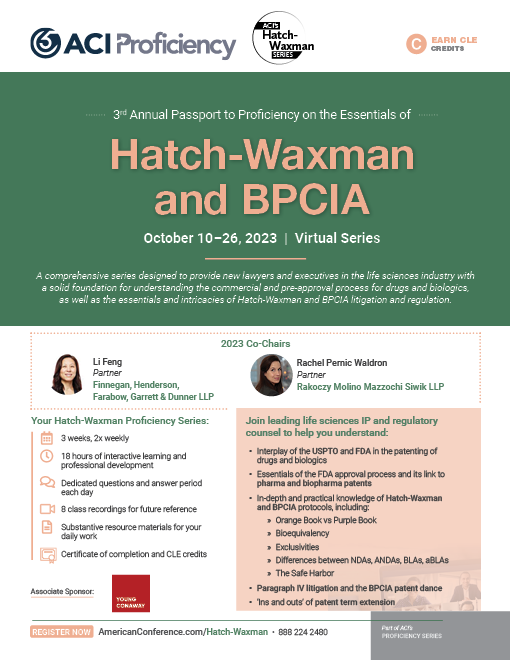Agenda
Agenda
ACI’s highly anticipated Proficiency Series provides true immersion in Hatch-Waxman and BPCIA Essentials with the objective of becoming proficient in three weeks.

Download 2023 Brochure
Flip through our 2023 conference brochure and discover what’s new this year.
DAY 1
MODULE 1
Tuesday, October 10 • 1:00pm–4:15pm EST
1:00pm Co-Chairs’ Opening Remarks
1:15pm Key Agencies Overview: Understanding the Jurisdiction and Interplay of the FDA and PTO in the Patenting of Drugs and Biologics
Understanding the respective roles and interplay of the FDA and PTO in the patenting and approval of drugs and biological products
FDA
- FDA overview and organization
- Department of Health and Human Services and the Commissioner
- The 5 FDA Centers and the Office of Regulatory Affairs and their functions
- CDER (Drug) and CBER (Biologic) overview
- Defining the scope of the FDA’s jurisdiction with respect to drugs and biologics
- Examining how the FDA exercises its jurisdiction:
- Rule making
- Product decisions
- Enforcement
- Informal mechanisms
- Reviewing the laws that the FDA enforces relative to the patenting of drug and biological products
- Food Drug & Cosmetic Act
- Prescription Drug Marketing Act
- Public Health Services Act
- Hatch-Waxman Act
- Other applicable laws
- Defining drugs and biologics
- Labeling: when is a drug a drug and not a biologic
- Working with the FDA
- Administrative Procedures Act
- formal and informal dispute resolution mechanismss
The PTO
- Review of the organizational structure of the PTO
- Patents: overview of drug and biological products that may be patented
- Who may apply for a patent? What are the requirements for patentability?
- Agency and inventorship
- What is the PTO’s jurisdiction in the patenting of drugs and biologics?
- What laws and regulations does the PTO enforce relative to the patenting of drugs and biologics?
- Patent Reform Legislation
- Trademarks vis-à-vis drugs and biologics
2:30pm Break
2:45pm Identifying and Comprehending Pre-Commercialization Concerns Relative to Small Molecules and Biologics
The current pre-commercialization landscape:
- Reviewing the types of products that pharmaceutical, biotechnology and biopharmaceutical companies seeking to develop now
- Identifying impediments — through patent or regulatory restraint — which prevent these companies from pursuing the development of the desired product
- FDA hurdles that may not clear even if all patent and other IP hurdles are met
- Techniques for analyzing the value the product adds to the company’s portfolio, and methods for proving value
- Assessing the competition and analyzing potential therapeutic interchange considerations
Considerations in light of Health Care Reform:
- Understanding how the introduction of follow-on biologics will change the commercial landscape
- Examining the role of the Center for Medicare and Medicaid Services (CMS) in the approval process and its impact on R&D
- The connection between CMS approval and commercial viability via government payor systems and rebates
- Comparative effectiveness
3:45pm Questions and Answers
4:15pm Day One Adjourns

Li Feng
Partner
Finnegan, Henderson, Farabow, Garrett & Dunner, LLP

Rachel L. Pernic Waldron
Partner
Rakoczy Molino Mazzochi Siwik LLP

David B. Abramowitz
Partner
Locke Lord LLP

Jordan Garner
Partner
Leason Ellis LLP

Hassan Sayeed
Partner
O’Melveny & Myers LLP

Anna Brook
Partner
Culhane Meadows Haughian & Walsh PLL
DAY 2
MODULE 2
Thursday, October 12 • 1:00pm–5:00pm EST
1:00pm Exploring the Link between the FDA Approval Process and the Patenting of Drugs and Biologics
Rx Drugs (new drugs)
- Identifying the application process for the approval of a new drug, i.e., small molecule, new chemical entities, etc.
- NDA (New Drug Application): definition, contents and regulatory overview
- INDA (Investigational New Drug Application) aka “IND”
- How does it differ from an NDA?
- Accelerated approvals
- Defining eligibility criteria for accelerated approval and priority reviews
- What portions of approval submissions might FDA release and when?
- Using advisory committees in the approval process
Biologics
- How does the approval process for a biologic differ from that of a drug?
- BLA (Biological Licensing Application): application and filing
- How does a biologic differ from a drug?
- Which products require BLAs instead of NDAs?
- Why is it a “license,” rather than an “approved application”?
2:15pm Break
2:30pm Small and Large Molecule Drug Patents and Other Related IP Protections and Mechanisms
Patent Protections for Drugs and Biologics
- Summarizing the patenting process for drugs and biologics
- Strategies for building patent protection for drugs and biologics
- Applying for and achieving extension of patent term for time spent in the drug approval process
- Patent Term Extension (“PTE”) / Patent Term Adjustment (“PTA”) synopsis
- Reviewing the 271(e)(1) “safe harbor” provision
- Distinguishing the patenting process for drugs from that of biologics
Trademark, Trade Name, and Trade Dress Protections
- Overview of selecting a brand name for a proposed drug product
- Roles of the USPTO and FDA in the drug naming process
- Identifying the PTO and FDA clearances necessary for trade name/ trademark approval on your product
- Understanding the importance of trade dress
- How does the branding process work for your product
3:30pm The Orange Book: Listings, De-Listings and Other Matters of Interest
- What is the Orange Book, what does it contain, and why is it orange?
- FDA’s publication on Approved Drug Products with Therapeutic Equivalence Evaluations
- Understanding the role of Orange Book listings in patent life cycle management and patent portfolio management
- Exploring the continuing dilemma of which patents should be listed, delisted, and held in reserve
- Examining the FDA’s position on not listing a patent
- Overcoming challenges associated with listing patented information in the product label and indications discovered in clinical testing
- Incorporating long term patent listing strategies into label negotiations with FDA
- The ongoing skinny labeling and carve-out conundrum
- Assessing the scope of potential Orange Book listing controversies relative to:
- Device patents
- Product-by-process claims
- Metabolites; polymorphs; intermediates
- Patents on unapproved uses
4:30pm Questions and Answers
5:00pm Co-Chairs’ Closing Remarks and Week One Adjourns

Alison Baldwin
Partner
Faegre Drinker Biddle & Reath LLP

John Goetz
Principal
Fish & Richardson P.C.

Andrea Weiss Jeffries
Partner
Jones Day

Emily J. Greb
Partner
Perkins Coie LLP

Sara W. Koblitz
Director
Hyman, Phelps & McNamara PC

Thomas Irving
Senior Partner
The Marbury Law Group, PLLC

Shashank Upadhye
Registered Patent Attorney
Upadhye Tang LLP
DAY 1
MODULE 3
Tuesday, October 17 • 1:00pm–5:00pm EST
1:00pm Co-Chairs’ Opening Remarks
1:15pm The Hatch-Waxman Landscape: ANDAs, and Exclusivities
- Overview of Hatch-Waxman and reforms
- Comparing the NDA, 505(b)(2), and ANDA (Abbreviated New Drug Application) drug approval routes
- Reviewing fundamentals of applications
- Examining ANDA Standards for approval and the concepts of sameness and bioequivalence
- Special considerations: local acting drugs, labeling carve outs and other nuances
- Understanding the role of the Orange Book in the drug approval process
- Listings, de-listings and use codes
- Market exclusivities and protection
- Identifying the different types of exclusivities
- Regulatory exclusivity (FDA)/(data) exclusivity
- NCE (new chemical entity)
- 5 years data exclusivity
- Indication (new indication or use)
- 3 years marketing exclusivity
- NDF (new dosage formulation)
- ODE (orphan drug exclusivity)
- PED (pediatric exclusivity)
- Regulatory exclusivity (FDA)/(data) exclusivity
2:45pm Break
3:00pm Paragraph IV Disputes and Litigation
- Exploring the ANDA Paragraph IV Certification, and response to Notice Letters
- Pre-suit considerations
- Initial pleadings
- Multiple ANDA filers
- Declaratory judgments
- Typical Paragraph IV litigation scenarios -hypotheticals
- 30-month stay; patent extensions; ANDA filer exclusivity (180 day)
- Preparing for parallel litigation before the PTAB
- IPR overview
- Hot buttons in Hatch-Waxman litigation
- Settlements
- Damages
- Double-patenting
4:30pm Questions and Answers
5:00pm Day One Adjourns

Li Feng
Partner
Finnegan, Henderson, Farabow, Garrett & Dunner, LLP

Rachel L. Pernic Waldron
Partner
Rakoczy Molino Mazzochi Siwik LLP

Daniel Klein
Counsel
Groombridge, Wu, Baughman & Stone LLP

Frederick Ball
Partner
Duane Morris LLP

Dov Grossman
Partner
Williams & Connolly LLP

Keeto Sabharwal
Partner
Husch Blackwell
DAY 2
MODULE 4
Thursday, October 19 • 1:00pm–4:45pm EST
1:00pm Biosimilars: The BPCIA, aBLA Overview
- Overview of biosimilar legislation and regulations, i.e., Biologics Price Competition and Innovation Act of 2009 (BPCIA)
- Understanding the rationale for safety and efficacy concerns surrounding second generation biologics or aBLAs
- Exploring the concepts of “biosimilarity” or “interchangeability”
- FDA rulemaking and guidance relative to biosimilars
- Other points for consideration: substitution, naming, patents, and additional nuances
- The Purple Book
- Examining biosimilar exclusivities
2:30pm Break
2:45pm “Shall We Dance” — Weighing the Pros and Cons of Participating in the BPCIA Patent Dance
- Deciding when to provide notice of commercial marketing
- Addressing contentions and controversies in the aBLA information exchange
- Understanding how biosimilar applicants can command the stride of litigation under the BPCIA
- Evaluating what is “manufacturing information”
- Appreciating the limitations on declaratory judgment actions
- Analyzing the biosimilar and innovator perspectives when deciding whether to dance
3:45pm The Purple Book
- What is the purple book and what does it contain?
- Lists of Licensed Biological Products with Reference Product Exclusivity and Biosimilarity or Interchangeability Evaluations
- FDA’s interpretation of what is included in the list
- Understand the obligations of Reference Product sponsors under Section 325 (“Biological Product Patent Transparency”), ‘The Purple Book Act’
- Evaluating how new requirements of including patent information will impact the ‘patent dance’
- Appreciating the differences in the Orange Book and Purple Book listing
- Addressing how new information requirements will affect business strategies
4:15pm Questions and Answers
4:45pm Co-Chairs’ Closing Remarks and Week Two Adjourns

Li Feng
Partner
Finnegan, Henderson, Farabow, Garrett & Dunner, LLP

Rachel L. Pernic Waldron
Partner
Rakoczy Molino Mazzochi Siwik LLP

Daniel P. Margolis
Partner
Allen & Overy LLP

Bryan Vogel
Partner
Robins Kaplan LLP

April Weisbruch
Partner
McDermott Will & Emery LLP

Kyle Musgrove
Partner
Parker Poe Adams & Bernstein LLP

Gary Veron
Partner
Hogan Lovells

Charles Klein
Partner
Winston & Strawn LLP
DAY 1
MODULE 5
Tuesday, October 24 • 1:00pm–5:00pm EST
1:00pm Co-Chairs’ Opening Remarks
1:15pm In-Depth Drill-Down on Bioequivalence, “Same Active Ingredient”, and Interchangeability
- Defining bioequivalence in drugs and biologics
- Drugs v. biologics
- What an ANDA-filer must demonstrate for bioequivalence?
- Bioequivalence and dosage form – oral tablet/capsule, injection, nasal sprays, topical, nasal sprays
- How does bioequivalence relate to patents?
- Patenting of bioequivalence characteristics – extended-release drug products
- Bioequivalence v. Doctrine of Equivalents – what is the difference?
- Arguments about bioequivalence raised in Paragraph IV patent litigation
- Infringement, copying (non-obviousness)
2:15pm Break
2:30pm An In-Depth Look at 180- Day Exclusivity
- Understanding 180-day generic market exclusivity under the Hatch-Waxman Act
- What are the qualifying criteria for exclusivity?
- How can an ANDA applicant really determine who is "first-to-file" and win 180 –day exclusivity?
- Identifying triggers for the running of the 180-day exclusivity period
- Deciphering the FDA’s new interpretation of pre- and post- MMA 180 day exclusivity
- what are the implications of this interpretation for products having ANDA’s filed prior to the enactment of the MMA?
- Exploring the interplay between the 30-month stay and 180-day exclusivity
- Forfeiture provisions: identifying circumstances under which exclusivity is forfeited
- Other circumstances that may trigger the loss of 180-day exclusivity
- When can the 180-day exclusivity period be transferred to another ANDA applicant?
- Evaluating when the 180-day exclusivity period can be relinquished, and exploring the consequences defining "shared exclusivity"
3:30pmComprehending the Intricacies of Non-Patent/ Regulatory Exclusivity
- Understanding which drug products are eligible for regulatory exclusivity
- Small biologics v. biologics
- The different modes and methods of regulatory exclusivity (non-patent)
- NCE (new chemical entity): 5 years marketing exclusivity/5 years data exclusivity
- Indication (new indication or use): 3 years marketing exclusivity
- NDF (new dosage formulation)
- ODE (orphan drug exclusivity)
- PED (pediatric exclusivity)
- FD&C 505b2 (alternate pathway to ANDA) a/k/a paper NDA
- What role does the FDA play in regulating these modes of exclusivity?
- When are each of these methods sought?
- Using trade dress as means of exclusivity
4:30pm Questions and Answers
5:00pm Day One Adjourns

Li Feng
Partner
Finnegan, Henderson, Farabow, Garrett & Dunner, LLP

Rachel L. Pernic Waldron
Partner
Rakoczy Molino Mazzochi Siwik LLP

Christina Markus
Partner
King & Spalding LLP

Jordan Markham
Partner
Steptoe & Johnson LLP

Christopher Noyes
Partner
WilmerHale

Brian Burgess
Partner
Goodwin Procter LLP

Lara E. FitzSimmons
Partner
Rakoczy Molino Mazzochi Siwik LLP
DAY 2
MODULE 6
Thursday, October 26 • 1:00pm–4:45pm EST
1:00pm Assessing Patent Protections Afforded Under the Safe Harbor
- Exploring the safe harbor of the Hatch-Waxman Act 35 USC § 271(e)(1)
- Understanding the safe harbor’s scope of protection for otherwise infringing activities
- Examining the safe harbor protections afforded to research tool patents
- Identifying safe harbor protections relative to:
- Basic R&D
- New product screening
- Optimization
- Pre-clinical testing
- Post-approval testing
2:15pm Break
2:30pm Examining Pharmaceutical Patent Extensions: Patent Term Adjustment and Patent Term Restoration
- Extension of patent term under 35 U.S.C. § 156 and 37 CFR 1.710 – 1.791
- Exploring the viability of extension applications to:
- Basic and combination compounds; secondary patents
- Important benchmarks in the drug’s development and patent timelines
- Eligibility for patent term extension
- Regulatory review period determinations
- How to calculate the patent term restored
- Respective roles of the FDA and PTO in granting patent extensions
- Third-party challenges — “diligence”
- Patent term extensions outside the U.S.
- Examining patent term adjustment due to delays in prosecution before the USPTO
- Strategies for:
- Diligence in prosecution by the patent applicant
- Calculating the adjustment period
- Strategies for:
- Understanding the link between patent extensions and exclusivity
- Extensions obtained through FDA Pediatric Exclusivity and Orphan Drug Exclusivity
- Obtaining patent coverage for pharmaceuticals through the use of second-generation patents, e.g.,
- Maintaining patent position for second-generation products
- Approaches taken by pharmaceutical companies in obtaining second-generation patents
- Enforcement of second-generation patents
4:00pm Question and Answer Wild Card
4:45pm Co-Chairs’ Final Comments and Proficiency Series Adjourns

Li Feng
Partner
Finnegan, Henderson, Farabow, Garrett & Dunner, LLP

Rachel L. Pernic Waldron
Partner
Rakoczy Molino Mazzochi Siwik LLP

David Frazier
Partner
Latham & Watkins LLP

Rob Vrana
Partner
Young Conaway Stargatt & Taylor, LLP

Fabian Koenigbauer
Partner
Ice Miller LLP

Matthew S. Murphy
Partner
Axinn, Veltrop & Harkrider LLP